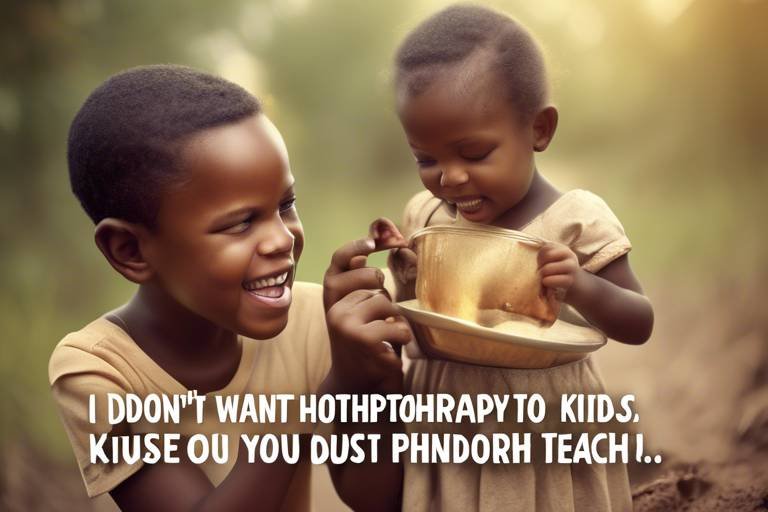Talking to Your Child About Bullying
As a parent, navigating the complex world of childhood can often feel like walking a tightrope. You want to ensure your child feels safe, understood, and empowered. However, when it comes to the sensitive topic of bullying, the path can become even more challenging. It's crucial to foster an environment where your child feels comfortable discussing their experiences, especially when it comes to bullying. This article provides insights and strategies for parents on how to effectively communicate with their children about bullying, fostering understanding and resilience while ensuring a supportive environment.
Let's kick things off by defining what bullying really is. Bullying isn't just a one-time incident; it's a pattern of behavior that can take many forms. It can be physical, like pushing or hitting; verbal, such as name-calling or teasing; or even digital, known as cyberbullying, which can happen through social media or texting. Each type of bullying can have a profound impact on a child's emotional and psychological well-being. Understanding these distinctions is vital for parents to educate their children effectively. By recognizing the various forms of bullying, you can better equip your child to handle these situations and encourage them to speak up.
Now that we have a grasp on what bullying is, how can you tell if your child is experiencing it? It's essential for parents to be vigilant and aware of the signs that may indicate their child is being bullied. Behavioral changes, emotional distress, and physical symptoms can all serve as red flags. For instance, if your once outgoing child suddenly becomes withdrawn or shows a dip in their academic performance, this could be a sign that something is amiss. Additionally, increased anxiety or irritability can also signal that your child is struggling with bullying. Keeping an eye on these signs can help you intervene early and provide the support your child needs.
Sudden shifts in behavior can be alarming and often serve as a cry for help. If you notice your child withdrawing from friends or activities they once enjoyed, it's time to take a closer look. Behavioral changes could manifest in various ways, such as:
- Increased isolation from peers
- Declining grades or lack of interest in school
- Changes in eating or sleeping patterns
These changes are not just typical growing pains; they may indicate that your child is facing bullying. Being proactive in addressing these issues is essential.
Emotional distress can often be more challenging to identify. Children may not have the words to express what they’re feeling, but you might notice mood swings or irritability that seem out of character. If your child appears more anxious than usual or frequently expresses feelings of sadness, these could be signs that they are facing bullying. It's vital to create a safe space where they can talk freely about their feelings without fear of judgment.
Sometimes, the signs of bullying manifest physically. Unexplained injuries, frequent headaches, or stomachaches can be indicators that your child is experiencing stress related to bullying. It's crucial to pay attention to these symptoms and consider their potential connection to bullying. If your child consistently complains of physical ailments, it may be worth having a conversation about what might be troubling them.
Establishing a supportive environment is essential for open communication. As a parent, you can create a safe space for your child by being approachable and non-judgmental. Encourage your child to share their feelings and experiences, and let them know that it's okay to talk about bullying. This supportive atmosphere can make a world of difference, allowing your child to feel secure in expressing themselves.
Open dialogue is key when discussing bullying. Parents should feel empowered to use effective communication strategies that ensure their child feels heard and understood. One of the most important techniques is practicing active listening. This means truly focusing on what your child is saying without interrupting or jumping to conclusions. By validating their feelings, you can help them feel more comfortable sharing their experiences.
Active listening is more than just hearing words; it involves engaging with your child emotionally and intellectually. When your child talks about their experiences, reflect back what you hear to show that you understand. This could be as simple as saying, "It sounds like you're feeling really hurt by what happened." Such validation can be incredibly powerful, making your child feel supported and understood.
Encouraging your child to talk about their feelings fosters trust. Ask open-ended questions that invite discussion, such as, "How was your day at school?" or "Have you noticed anything different with your friends lately?" This approach can help initiate conversations about bullying in a natural way, making it easier for your child to share their experiences without feeling pressured.
Q: What should I do if my child tells me they are being bullied?
A: Listen to them without judgment, validate their feelings, and assure them that it's not their fault. Discuss potential steps to take, such as talking to a teacher or school counselor.
Q: How can I help my child build resilience against bullying?
A: Encourage them to engage in activities they enjoy, build friendships, and develop self-confidence. Role-playing scenarios can also help them practice responses to bullying.
Q: Should I confront the bully's parents?
A: It's generally best to work through school authorities first. They can mediate the situation and ensure that proper steps are taken to address the bullying.

Understanding Bullying
Understanding bullying is the first step in helping your child navigate the complex social landscape of childhood. Bullying isn’t just a single act; it’s a pattern of behavior that can have serious and lasting effects on a child's mental and emotional well-being. To effectively communicate with your child about this issue, it’s essential to define what bullying really means. Bullying can take many forms, and recognizing these variations can empower both you and your child.
There are three primary types of bullying that parents should be aware of:
- Physical Bullying: This involves hitting, kicking, or any form of physical aggression. It’s often the most visible type and can leave noticeable marks, but it’s not the only way children can be hurt.
- Verbal Bullying: This includes name-calling, teasing, or threatening. It may seem less harmful than physical bullying, but the emotional scars can run deep.
- Cyberbullying: In our digital age, bullying can also occur online through social media, texts, or emails. This form can be particularly insidious as it can happen 24/7 and often hides behind the anonymity of the internet.
Each of these types of bullying can lead to significant emotional turmoil for your child. The impacts can range from low self-esteem and anxiety to depression and even suicidal thoughts in severe cases. It’s crucial for parents to understand that bullying is not just a rite of passage; it can have real, damaging consequences that affect a child's ability to learn and socialize.
Moreover, understanding the underlying reasons why bullying occurs can help parents address the issue more effectively. Often, bullies themselves may be struggling with their own issues, such as insecurity or a lack of empathy. By fostering a culture of kindness and respect at home, parents can help reduce the likelihood of their child becoming either a victim or a perpetrator. It’s about creating an environment where empathy is valued and differences are celebrated.
In conclusion, recognizing the different forms of bullying and understanding their potential impacts is vital for parents. This knowledge not only helps you support your child but also equips you to engage in meaningful conversations about bullying. The more informed you are, the better you can guide your child through these challenging experiences.

Recognizing Signs of Bullying
As a parent, it's crucial to be vigilant and recognize the signs that your child might be experiencing bullying. Bullying can manifest in various ways, and understanding these signs can help you intervene early and provide the support your child needs. It's not always easy to spot, as children often hide their feelings, but there are several indicators that can give you a clue that something is wrong. The first step is to be observant of any behavioral changes that deviate from your child's norm.
One of the most telling signs of bullying is a sudden shift in behavior. If your typically outgoing child becomes withdrawn, it could be a signal that they are facing challenges at school or with their peers. Look out for changes such as:
- Withdrawal from friends and social activities
- Declining academic performance or a sudden drop in grades
- Increased anxiety or nervousness, especially about going to school
These changes can be alarming, and it's essential to approach the situation with care. Instead of jumping to conclusions, try to engage your child in a gentle conversation. Ask open-ended questions that encourage them to share their feelings without fear of judgment.
Emotional distress is another significant indicator that your child may be dealing with bullying. Children often express their feelings through mood swings or irritability. If your child seems more emotional than usual, it might be a sign that they are struggling with something deeper. Watch for signs such as:
- Frequent crying spells or emotional outbursts
- Sudden changes in their appetite or sleep patterns
- Increased frustration or anger, especially when discussing school
Understanding these emotional cues can help you create a safe space for your child to express themselves. Remind them that it's okay to feel upset and that you're there to listen and support them.
Physical symptoms can sometimes be the most alarming signs of bullying. Children may experience unexplained injuries, frequent headaches, or stomachaches that seem to have no medical cause. These physical manifestations can serve as an outlet for the stress and anxiety they are feeling. For instance, if your child comes home with bruises they can't explain or mentions feeling sick on school days, it might be time to dig a little deeper.
It's essential to approach these signs with empathy. Instead of demanding explanations, try to foster an environment where your child feels safe discussing their experiences. Often, they may not connect their physical symptoms with bullying, so your gentle guidance can help them articulate what they are going through.
By being aware of these signs—behavioral changes, emotional distress, and physical symptoms—you can better support your child. Remember, recognizing the signs of bullying is the first step in addressing the issue and helping your child navigate their feelings and experiences.
Q: What should I do if I suspect my child is being bullied?
A: Start by having an open and honest conversation with your child. Encourage them to share their feelings and experiences. It's important to listen without judgment and validate their feelings. If necessary, involve school authorities to address the situation.
Q: How can I help my child build resilience against bullying?
A: Teach your child coping strategies, such as assertiveness training and problem-solving skills. Encourage them to engage in activities that boost their confidence and self-esteem, and remind them that they can always come to you for support.
Q: What resources are available for parents dealing with bullying?
A: There are numerous resources available, including books, websites, and local support groups. Organizations like StopBullying.gov provide valuable information and guidance for parents and children alike.

Behavioral Changes
When it comes to understanding whether your child might be facing bullying, one of the most telling signs can be found in their . Children are often like open books, their actions speaking volumes about their emotional state. If you notice a sudden shift in your child's behavior, it could be a red flag that something is amiss. For instance, they might start to withdraw from friends they once enjoyed spending time with, opting instead to isolate themselves. This retreat can be alarming, as social connections are crucial for a child's emotional health.
Additionally, you may observe changes in their academic performance. Is your child suddenly struggling with homework or grades? This could indicate that they are preoccupied with the emotional turmoil that bullying brings, making it challenging to focus on schoolwork. It's essential to pay attention to these shifts; they can often be a cry for help hidden beneath layers of confusion and fear.
Another behavioral sign to watch for is an increase in anxiety. If your child seems more nervous or fearful than usual, it may be a sign that they are dealing with something distressing. They might express this anxiety through physical symptoms, such as stomachaches or headaches, which can often be psychosomatic responses to stress. As a parent, you have the opportunity to step in and provide the support they need to navigate these difficult emotions.
In summary, recognizing these behavioral changes is crucial for parents. By staying attuned to your child's actions and reactions, you can create an environment that encourages them to open up about their experiences. Remember, the earlier you can identify potential bullying, the better equipped you will be to help your child cope and find solutions. It's all about fostering a trusting relationship where they feel safe to express their feelings without fear of judgment.
- What should I do if I suspect my child is being bullied? - Start by having an open conversation with them, encouraging them to share their feelings and experiences.
- How can I help my child cope with bullying? - Provide emotional support, validate their feelings, and consider involving school authorities if necessary.
- Are there specific signs that indicate a child is being bullied? - Yes, look for behavioral changes, emotional distress, and physical symptoms such as unexplained injuries.

Emotional Distress
When it comes to children facing bullying, emotional distress often manifests in various ways that can be subtle yet significant. As a parent, understanding these signs is crucial for providing the necessary support. Children who are being bullied may experience mood swings that can leave you wondering if they’re just going through a phase or if something more serious is at play. They might go from being cheerful and energetic to withdrawn and irritable almost overnight. This drastic change can be alarming, and it’s essential to approach it with sensitivity and care.
Moreover, emotional distress can lead to feelings of anxiety and depression. A child might express feelings of hopelessness or worthlessness, which can be heartbreaking to witness. You might hear them say things like, “I’m not good enough” or “Nobody likes me.” These statements are red flags that indicate they might be struggling with their self-esteem due to bullying. It is vital to create an environment where they feel safe to express these feelings without fear of judgment.
Additionally, physical manifestations of emotional distress can also occur. Children might complain of stomachaches or headaches that seem to have no medical explanation. These symptoms can often be linked to the stress and anxiety they are experiencing. It’s like their body is reacting to the emotional turmoil they can’t quite articulate. Understanding this connection can help you approach the situation with empathy and encourage your child to talk about what’s bothering them.
To effectively support your child, consider these strategies:
- Encourage Expression: Urge your child to express their feelings through art, writing, or conversation. This can help them process their emotions.
- Validate Their Feelings: Let them know that it’s okay to feel upset or angry about their experiences. Acknowledging their feelings can provide comfort.
- Seek Professional Help: If emotional distress persists, consider consulting a psychologist or counselor who specializes in childhood trauma.
In conclusion, recognizing emotional distress in your child is the first step towards helping them cope with bullying. By fostering an open dialogue and providing a supportive environment, you can help them navigate their feelings and build resilience against the challenges they face. Remember, it’s not just about addressing the bullying; it’s also about helping your child heal emotionally and regain their confidence.
Q1: How can I tell if my child is being bullied?
A1: Look for signs such as changes in behavior, emotional distress, or physical symptoms like unexplained injuries or frequent headaches.
Q2: What should I do if my child confides in me about being bullied?
A2: Listen actively and validate their feelings. Encourage them to talk about their experiences and reassure them that they are not alone.
Q3: How can I create a safe space for my child to discuss bullying?
A3: Establish a non-judgmental environment where your child feels comfortable sharing their feelings. Make time for regular conversations and show genuine interest in their well-being.

Physical Symptoms
When it comes to understanding the impact of bullying on children, can sometimes be the most alarming indicators. These symptoms may not just be coincidental; they can be a direct reflection of the emotional turmoil your child is experiencing. It's essential to recognize that children often express their distress through their bodies, and being aware of these signs can help you intervene early and effectively.
For instance, if your child frequently complains of headaches or stomachaches, it may not merely be a case of a common illness. These complaints can often stem from anxiety and stress related to bullying. Similarly, unexplained injuries, such as bruises or scratches, should raise a red flag. If your child is reluctant to explain how they got hurt or seems to be hiding their body, it could indicate they're facing bullying at school or in other social settings.
Here are some common physical symptoms to watch out for:
- Frequent headaches: Persistent head pain can be a sign of stress or anxiety.
- Stomach issues: Complaints of nausea or stomach pain may indicate emotional distress.
- Unexplained injuries: Look for bruises, cuts, or other injuries that your child cannot account for.
- Changes in sleep patterns: Trouble sleeping or excessive tiredness can also be a sign of underlying issues.
It's crucial to approach these symptoms with compassion and understanding. Instead of jumping to conclusions, engage your child in a gentle conversation about how they’re feeling. Ask open-ended questions that allow them to express their concerns without feeling pressured. For example, instead of saying, "Did someone hurt you?" you might ask, "I've noticed you've seemed upset lately. Can you tell me more about what's been going on?" This approach not only opens the door for dialogue but also reassures your child that they are in a safe space to share their experiences.
Moreover, if you notice a combination of these physical symptoms alongside behavioral changes, such as withdrawal from social activities or a sudden drop in academic performance, it might be time to take further action. Consider consulting with a professional, such as a school counselor or child psychologist, who can provide additional support and resources. Remember, acknowledging these physical signs is not just about addressing the symptoms; it’s about understanding the deeper emotional issues your child may be facing.

Creating a Safe Space
Creating a safe space for your child to talk about bullying is not just important; it’s absolutely essential. Imagine this safe space as a cozy nook in your home, a little sanctuary where your child feels free to express their thoughts and feelings without the fear of judgment. It’s a place where they can let their guard down and share their experiences openly. To foster this atmosphere, parents should focus on several key strategies that can help build trust and encourage honesty.
First and foremost, it’s crucial to set aside dedicated time for these conversations. Just like you wouldn’t rush through a family dinner, don’t rush through discussions about bullying. Make it a regular part of your routine. Perhaps you could designate a specific time each week, like during a car ride or while cooking dinner together, to check in on how things are going at school. This consistent approach signals to your child that you genuinely care about their well-being.
Additionally, creating a comfortable physical environment can significantly impact the quality of these discussions. Whether it’s snuggling up on the couch with a favorite blanket or sitting together in a quiet corner of the backyard, choose a space that feels warm and inviting. You might even consider using soft lighting or calming music in the background to help ease any tension. The goal is to make your child feel relaxed and at ease, which can open the door to more honest conversations.
Another vital aspect is to actively demonstrate that you are emotionally available. This means putting down your phone, turning off the TV, and giving your undivided attention when your child speaks. Acknowledge their feelings with phrases like, “I can see this is really bothering you,” or “It’s okay to feel upset about this.” Such affirmations not only validate their emotions but also reinforce that it’s safe to share their thoughts with you.
Moreover, it’s important to remind your child that they are not alone in this journey. Share stories of your own childhood experiences, whether they are related to bullying or simply facing challenges. This not only humanizes you in their eyes but also shows them that everyone faces struggles at some point. It’s like shining a light in a dark room; it helps them see that they can get through tough times with the right support.
Finally, consider incorporating some fun and engaging activities into your safe space. This could include reading books together that address themes of friendship and kindness or watching movies that tackle bullying in a thoughtful way. These activities can serve as great conversation starters, allowing your child to express their thoughts on the topics presented without feeling pressured. Remember, the aim is to create a dialogue that feels natural and supportive.
In summary, creating a safe space for your child involves a combination of setting the right environment, being emotionally present, sharing experiences, and engaging in supportive activities. By implementing these strategies, you not only encourage your child to open up about their feelings but also strengthen your bond, making it easier for them to approach you when they need help. After all, in a world where bullying can feel overwhelming, having a safe haven at home makes all the difference.
- What should I do if my child refuses to talk about bullying?
It’s important to remain patient and continue to show your support. Sometimes, children may need time to process their feelings before they are ready to talk. Keep the lines of communication open and let them know you are there for them whenever they feel ready.
- How can I encourage my child to stand up against bullying?
Teach them the importance of empathy and kindness. Role-playing different scenarios can also help them practice how to respond to bullying situations in a safe environment.
- Are there specific signs I should look for that indicate my child is being bullied?
Yes, some common signs include sudden changes in behavior, withdrawal from friends, or unexplained injuries. It’s essential to keep an eye on these changes and approach your child with care and concern.

Effective Communication Strategies
When it comes to discussing bullying with your child, effective communication is the cornerstone of fostering understanding and resilience. Imagine trying to build a bridge; without a solid foundation, it won't hold up. Similarly, your conversations need to be built on trust and openness. So, how can you ensure that your child feels comfortable sharing their thoughts and feelings about bullying? Here are some strategies to consider.
First and foremost, active listening is crucial. This means giving your child your full attention when they speak. Put away distractions like your phone or TV, and make eye contact to show you’re genuinely interested. When you listen actively, you not only hear their words but also pick up on their emotions. For instance, if your child mentions feeling sad about something that happened at school, instead of jumping in with solutions, acknowledge their feelings by saying something like, “It sounds like that really upset you.” This simple validation can go a long way in making them feel understood.
Next, consider the environment in which you have these conversations. A safe space is essential. Create a cozy atmosphere—maybe during a car ride or while cuddled up on the couch. This setting can help your child feel more at ease. You might say, “I want to talk about something important, and I want you to know that whatever you share with me stays between us.” This assurance can help break down barriers and encourage your child to open up.
Another effective strategy is to ask open-ended questions. Instead of yes-or-no questions, try asking, “What happened at school today that made you smile?” or “Can you tell me more about how you felt when that happened?” This type of questioning invites your child to share more details and express their feelings. It’s like giving them a canvas to paint their experiences on, allowing for a richer conversation.
Additionally, encourage your child to express their feelings freely. You might say, “It’s okay to feel upset or angry about what happened. I’m here to listen.” This reassurance can help them feel secure in sharing their emotions without fear of judgment. Remember, sometimes kids just need to vent, and being their sounding board can be incredibly valuable.
Moreover, sharing your own experiences can be a powerful tool. When appropriate, relate a time when you faced a challenge, whether it was bullying or another difficult situation. This not only helps your child see that they are not alone but also opens the door for deeper conversations. You could say, “When I was your age, I faced something similar, and it made me feel really lonely. But talking about it helped me a lot.” This connection can foster empathy and trust.
Lastly, be patient and persistent. Sometimes, your child might not be ready to talk. That’s okay! Let them know that you’re there whenever they feel ready. You might say, “I’m always here to talk, no matter what. Just let me know when you want to share.” This ongoing support can create a sense of security, making it easier for them to come to you when they need to.
- What should I do if my child is reluctant to talk about bullying?
It's important to give them space while also reassuring them that you're available to listen whenever they're ready.
- How can I tell if my child is being bullied?
Look for signs like changes in behavior, emotional distress, or physical symptoms such as unexplained injuries.
- What if my child is the one bullying others?
Address the behavior calmly and seek to understand the underlying issues. Open communication is key to resolving these situations.

Active Listening
Active listening is more than just hearing the words your child says; it’s about truly engaging with them and understanding their feelings. Imagine you're on a rollercoaster, and your child is the one screaming in excitement or fear. You wouldn’t just nod along; you’d want to know what they’re feeling, right? This approach is crucial when your child talks about bullying. It shows them that their feelings are valid and that you care deeply about their experiences.
To practice active listening effectively, consider the following techniques:
- Maintain Eye Contact: This simple act can make a world of difference. It signals to your child that they have your full attention. When they see you focused on them, they’re more likely to open up.
- Reflect Back: After your child shares their thoughts, reflect back what you've heard. For example, if they say, “I feel alone at school,” you might respond, “It sounds like you’re feeling really isolated. That must be tough.” This not only shows you’re listening but also helps clarify their feelings.
- Avoid Interrupting: It can be tempting to jump in with advice or your own experiences, but resist the urge. Let your child express themselves fully before you respond. This builds trust and makes them feel valued.
- Validate Their Feelings: Whether they’re sad, angry, or confused, let them know that it’s okay to feel that way. You might say, “I understand why you’d feel that way. It’s a hard situation.” This affirmation can be incredibly comforting.
In addition to these techniques, it’s important to create an open atmosphere where your child feels safe to express their thoughts. You might consider setting aside regular times for these conversations, perhaps during a walk or while cooking together. The more relaxed the environment, the more likely they are to share their feelings about bullying or any other issues they might be facing.
Lastly, remember that active listening isn’t just about the words; it’s also about non-verbal cues. Your body language, facial expressions, and even your tone of voice can convey empathy and understanding. If you approach these conversations with an open heart and mind, you’ll not only strengthen your bond with your child but also empower them to face challenges like bullying with resilience.
Q1: What should I do if my child is reluctant to talk about bullying?
A1: It’s common for children to feel hesitant. You can gently encourage them by sharing your own experiences or by discussing general topics related to bullying. Make sure they know it’s a safe space to talk.
Q2: How can I tell if my child is being bullied?
A2: Look for signs such as sudden changes in behavior, withdrawal from friends, or unexplained injuries. If you notice anything unusual, it’s important to ask them directly but gently about their experiences.
Q3: What if my child tells me they are being bullied?
A3: Listen actively and validate their feelings. Then, discuss possible next steps together, such as talking to a teacher or school counselor. It’s crucial to support them through the process and ensure they feel safe.

Encouraging Open Dialogue
This article provides insights and strategies for parents on how to effectively communicate with their children about bullying, fostering understanding and resilience while ensuring a supportive environment.
Defining bullying is crucial for parents to educate their children. This section covers the different types of bullying, including physical, verbal, and cyberbullying, and their potential impacts on children.
Parents should be aware of the signs that may indicate their child is experiencing bullying. This section highlights behavioral changes, emotional distress, and physical symptoms to look out for.
Sudden shifts in behavior can be a red flag. This subsection discusses common behavioral changes, such as withdrawal from friends, changes in academic performance, and increased anxiety.
Children may exhibit emotional distress through mood swings or irritability. This part examines how to identify emotional signs that suggest a child might be facing bullying.
Physical signs such as unexplained injuries or frequent headaches can be indicators of bullying. This section explores how these symptoms relate to a child's experience.
Establishing a supportive environment is essential for open communication. This section offers tips on how parents can create a safe space for their children to express their feelings.
Open dialogue is key when discussing bullying. This section provides techniques for parents to communicate effectively, ensuring their child feels heard and understood.
Practicing active listening allows parents to fully understand their child's experiences. This subsection emphasizes the importance of listening without judgment and validating feelings.
Encouraging open dialogue about bullying can be a game changer for your child. It creates a safe environment where they feel comfortable sharing their thoughts and experiences. One effective way to initiate these conversations is by asking open-ended questions. For example, instead of asking, “Did someone bother you today?” try asking, “How was your day? Did anything interesting happen?” This approach invites your child to share more about their day without feeling pressured or defensive.
It’s also important to share your own experiences. When you talk about times when you felt bullied or left out, it not only normalizes their feelings but also shows them that they are not alone. This can be a powerful moment of connection. Remember, vulnerability breeds trust. When your child sees that you can be open about your feelings, they may feel encouraged to do the same.
Additionally, consider setting regular check-ins. These don’t have to be formal or lengthy; simply ask your child how they are feeling about school or their friends during dinner or while driving. Consistency is key here. It shows them that you care and are always available to listen.
Lastly, reinforce the idea that it’s okay to talk about tough subjects. You might say something like, “I know sometimes it can be hard to talk about bullying, but I want you to know that I’m here for you, no matter what.” This kind of reassurance can empower your child to open up when they need to.
- What should I do if my child tells me they are being bullied?
First, listen to them without judgment. Validate their feelings and reassure them that it’s not their fault. Discuss the next steps together, such as reporting the bullying to school authorities.
- How can I help my child build resilience against bullying?
Encourage them to engage in activities that boost their confidence, such as sports or arts. Teach them coping strategies and how to respond assertively to bullying.
- What if my child is the one bullying others?
Address the behavior immediately and discuss the impact of bullying on others. Work together to find ways to improve their behavior and develop empathy.
Frequently Asked Questions
- What is bullying and how can I define it for my child?
Bullying is a repeated aggressive behavior that can be physical, verbal, or emotional. It's essential to explain to your child that bullying involves an imbalance of power, where the bully intentionally harms or intimidates others. Help them understand the different types of bullying, including physical acts like hitting, verbal insults like name-calling, and cyberbullying through online platforms.
- What signs should I look for to identify if my child is being bullied?
Keep an eye out for behavioral changes such as withdrawal from friends or activities they once enjoyed. You might notice a drop in their academic performance or increased anxiety. Emotional distress can manifest as mood swings or irritability. Additionally, physical symptoms like unexplained injuries or frequent headaches may indicate they are facing bullying.
- How can I create a safe space for my child to talk about bullying?
Creating a safe space involves fostering an environment where your child feels comfortable expressing their feelings. Make it a habit to have regular check-ins where they can share anything on their mind. Ensure that your conversations are free from judgment, and emphasize that their feelings are valid and important.
- What are some effective communication strategies to discuss bullying?
Active listening is key when discussing bullying. Show genuine interest in what your child has to say, and avoid interrupting them. Encourage open dialogue by asking open-ended questions that prompt them to share their experiences. Reinforce trust by validating their feelings and assuring them that it's okay to talk about their struggles.
- How can I help my child build resilience against bullying?
Encourage your child to develop coping strategies, such as practicing assertiveness and problem-solving skills. Role-playing different scenarios can help them feel more prepared. Additionally, foster positive relationships with peers and adults, as a strong support network can empower them to stand up against bullying.



















